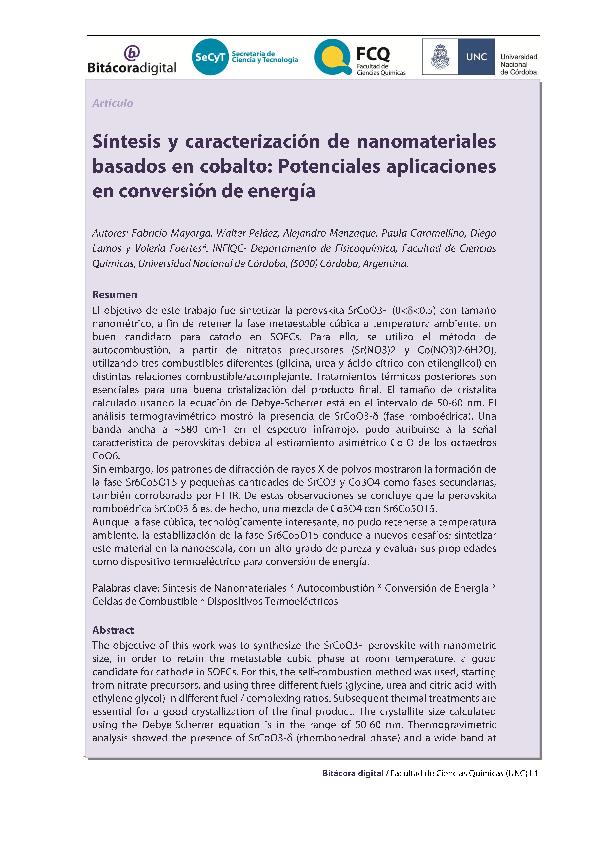Artículo
El objetivo de este trabajo fue sintetizar la perovskita SrCoO3-d con tamaño nanométrico, a fin de retener la fase metaestable cúbica a temperatura ambiente, un buen candidato para cátodo en SOFCs. Para ello, se utilizó el método de autocombustión, a partir de nitratos precursores, utilizando tres combustibles diferentes (glicina, urea y ácido cítrico con etilenglicol) en distintas relaciones combustible/acomplejante. Tratamientos térmicos posteriores son esenciales para una buena cristalización del producto final. El tamaño de cristalita calculado usando la ecuación de Scherrer está en el intervalo de 50-60 nm. El análisis termogravimétrico mostró la presencia de SrCoO3-d (fase romboédrica) y una banda ancha a ~580 cm-1 en el espectro infrarrojo, pudo atribuirse a la señal característica de perovskitas debida al estiramiento asimétrico Co-O de los octaedros CoO6.Sin embargo, los patrones de difracción de rayos X de polvos mostraron la formación de la fase Sr6Co5O15 y pequeñas cantidades de SrCO3 y Co3O4 como fases secundarias, también corroborado por FT-IR. De estas observaciones se concluye que la perovskita romboédrica SrCoO3-d es, de hecho, una mezcla de Co3O4 con Sr6Co5O15.Aunque la fase cúbica, tecnológicamente interesante, no pudo retenerse a temperatura ambiente, la estabilización de la fase Sr6Co5O15 conduce a nuevos desafíos: sintetizar este material en la nanoescala, con un alto grado de pureza y evaluar sus propiedades como dispositivo termoeléctrico para conversión de energía. The objective of this work was to synthesize the SrCoO3-d perovskite with nanometric size, in order to retain the metastable cubic phase at room temperature, a good candidate for cathode in SOFCs. For this, the self-combustion method was used, starting from nitrate precursors, and using three different fuels (glycine, urea and citric acid with ethylene glycol) in different fuel / complexing ratios. Subsequent thermal treatments are essential for a good crystallization of the final product. The crystallite size calculated using the Debye-Scherrer equation is in the range of 50-60 nm. Thermogravimetric analysis showed the presence of SrCoO3-? (rhombohedral phase) and a wide band at ~580 cm-1 in the infrared spectrum, could be attributed to the characteristic signal of perovskites due to the Co-O asymmetric stretching of the CoO6 octahedra. However, the X-ray diffraction powder patterns showed Sr6Co5O15 phase and small amounts of SrCO3 and Co3O4 as secondary phases, also corroborated by FT-IR. From these observations we conclude that the rhombohedral perovskite SrCoO3-? is, in fact, a mixture of Co3O4 with Sr6Co5O15. Although the technically interesting cubic phase could not be retained at room temperature, the stabilization of the Sr6Co5O15 phase leads to new challenges: to synthesize this material at the nanoscale with a high degree of purity and to evaluate its properties as a thermoelectric device for energy conversion.
Síntesis y caracterización de nanomateriales basados en cobalto: Potenciales aplicaciones en conversión de energía
Mayorga, Fabricio ; Peláez, Walter José
; Peláez, Walter José ; Menzaque, Alejandro Daniel
; Menzaque, Alejandro Daniel ; Caramellino, Paula; Lamas, Diego Germán
; Caramellino, Paula; Lamas, Diego Germán ; Fuertes, Valeria Cintia
; Fuertes, Valeria Cintia
 ; Peláez, Walter José
; Peláez, Walter José ; Menzaque, Alejandro Daniel
; Menzaque, Alejandro Daniel ; Caramellino, Paula; Lamas, Diego Germán
; Caramellino, Paula; Lamas, Diego Germán ; Fuertes, Valeria Cintia
; Fuertes, Valeria Cintia
Fecha de publicación:
12/2017
Editorial:
Universidad Nacional de Córdoba. Facultad de Ciencias Químicas
Revista:
Bitácoradigital
ISSN:
2344-9144
Idioma:
Español
Tipo de recurso:
Artículo publicado
Clasificación temática:
Resumen
Archivos asociados
Licencia
Identificadores
Colecciones
Articulos(INFIQC)
Articulos de INST.DE INVESTIGACIONES EN FISICO- QUIMICA DE CORDOBA
Articulos de INST.DE INVESTIGACIONES EN FISICO- QUIMICA DE CORDOBA
Citación
Mayorga, Fabricio; Peláez, Walter José; Menzaque, Alejandro Daniel; Caramellino, Paula; Lamas, Diego Germán; et al.; Síntesis y caracterización de nanomateriales basados en cobalto: Potenciales aplicaciones en conversión de energía; Universidad Nacional de Córdoba. Facultad de Ciencias Químicas; Bitácoradigital; 4; 8; 12-2017; 1-18
Compartir



